Attached files
| file | filename |
|---|---|
| 8-K - FORM 8-K - PHH CORP | y91587e8vk.htm |
Exhibit 99.1

| KBW Investment Management & Specialty Finance Conference June 7, 2011 Exhibit 99.1 |
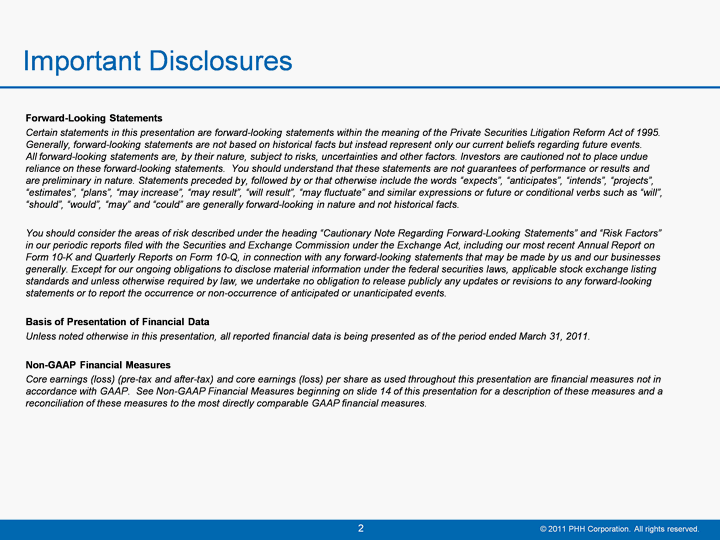
| Forward-Looking Statements Certain statements in this presentation are forward-looking statements within the meaning of the Private Securities Litigation Reform Act of 1995. Generally, forward-looking statements are not based on historical facts but instead represent only our current beliefs regarding future events. All forward-looking statements are, by their nature, subject to risks, uncertainties and other factors. Investors are cautioned not to place undue reliance on these forward-looking statements. You should understand that these statements are not guarantees of performance or results and are preliminary in nature. Statements preceded by, followed by or that otherwise include the words "expects", "anticipates", "intends", "projects", "estimates", "plans", "may increase", "may result", "will result", "may fluctuate" and similar expressions or future or conditional verbs such as "will", "should", "would", "may" and "could" are generally forward-looking in nature and not historical facts. You should consider the areas of risk described under the heading "Cautionary Note Regarding Forward-Looking Statements" and "Risk Factors" in our periodic reports filed with the Securities and Exchange Commission under the Exchange Act, including our most recent Annual Report on Form 10-K and Quarterly Reports on Form 10-Q, in connection with any forward-looking statements that may be made by us and our businesses generally. Except for our ongoing obligations to disclose material information under the federal securities laws, applicable stock exchange listing standards and unless otherwise required by law, we undertake no obligation to release publicly any updates or revisions to any forward-looking statements or to report the occurrence or non-occurrence of anticipated or unanticipated events. Basis of Presentation of Financial Data Unless noted otherwise in this presentation, all reported financial data is being presented as of the period ended March 31, 2011. Non-GAAP Financial Measures Core earnings (loss) (pre-tax and after-tax) and core earnings (loss) per share as used throughout this presentation are financial measures not in accordance with GAAP. See Non-GAAP Financial Measures beginning on slide 14 of this presentation for a description of these measures and a reconciliation of these measures to the most directly comparable GAAP financial measures. Important Disclosures |

| A leading provider of mortgage outsourcing and vehicle fleet management services PHH Overview 5th largest residential mortgage originator for the first quarter of 2011 2010 originations of $49B; 1Q11 originations of $13.8B 4th largest retail originator1 7th largest servicer as of 3/31/20111 $170B servicing portfolio Contractual relationships with financial institutions and real estate brokers Limited credit risk versus the industry "One stop" provider of fleet management services with a broad range of product offerings and best-in-class technologies >500,000 vehicles under management in the U.S. and Canada Well-diversified portfolio of leases to Fortune 500(r) Minimal residual risk 96% of our leases are "open-end" leases 1Source: Inside Mortgage Finance, copyright 2011 as of 3/31/11 YTD Mortgage Origination and Servicing Fleet Management |
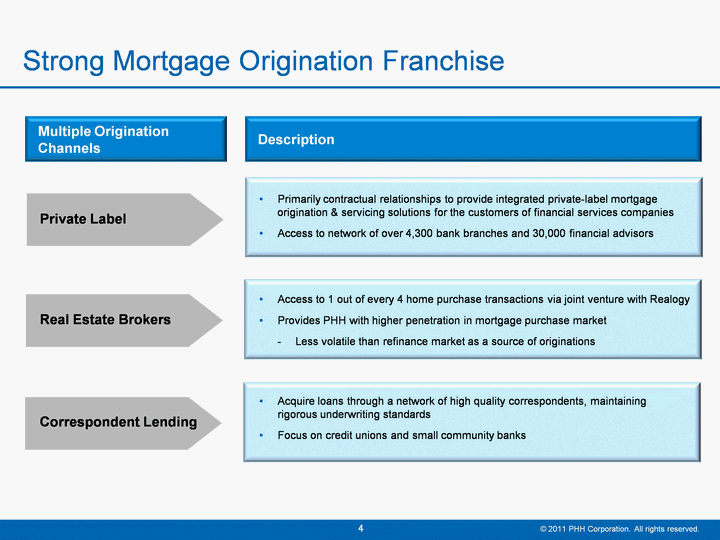
| Strong Mortgage Origination Franchise Private Label Multiple Origination Channels Description Real Estate Brokers Primarily contractual relationships to provide integrated private-label mortgage origination & servicing solutions for the customers of financial services companies Access to network of over 4,300 bank branches and 30,000 financial advisors Access to 1 out of every 4 home purchase transactions via joint venture with Realogy Provides PHH with higher penetration in mortgage purchase market Less volatile than refinance market as a source of originations Correspondent Lending Acquire loans through a network of high quality correspondents, maintaining rigorous underwriting standards Focus on credit unions and small community banks |

| Mortgage Origination Market Share *Source: Inside Mortgage Finance, Copyright 2011 and PHH internal analysis. PHH is a growth story - we grew mortgage volume 76% vs. 1Q 2010, the largest growth rate of the top 10 originators* We grew retail market share to 5.1% and overall share to 4.3% in 1Q 2011, with one of the best volume performances among the top ten lenders* Leading positions in all mortgage segments* # 7 Servicer # 4 Retail originator # 4 Jumbo originator # 4 FHA originator # 4 Purchase/# 5 Refinance |

| Illustrative Example of Mortgage Banking Profitability Origination Income (Loss) Cost to originate a $200,000 loan $(3,000) Less: application fee income $ 400 Net $(2,600) $(2,600) Cash gain when loan is sold $ 1,600 Float income (time in warehouse) $ 11 Total cash $ 1,611 $1,611 Net cost to originate $ (989) Servicing Income (annual income stream over the life of the loan) Annual servicing fee of 30 bps X $200,000 $600 NPV of servicing cash flows over the life of the loan (value created)* $2,400 *Capitalized Mortgage Servicing Right Note: Numbers are illustrative only, and may not relate to the actual or predicted economics of PHH's mortgage business for any particular period of time. Retail Origination Example |

| Grew servicing portfolio by almost 12% or $18B from 1Q10 Short-term prepayment speeds continue to be slower than modeled Weighted-average note rate dropped to 4.8%, enhancing long-term portfolio value MSR asset up by $132M from 1Q10 and capitalized servicing portfolio grew by over $12.5B, while servicing fees of the portfolio remain consistent at 30 bps Mortgage Servicing - Enhancing Long-Term Servicing Value * Includes sub-servicing portfolio Weighted Average Servicing Fee on capitalized portfolio 5.3% Wtd. Avg. Int. Rate 5.8% 5.2% 5.1% 5.2% 4.9% 4.8% (CHART) |

| (CHART) Servicing Portfolio Hedge Strategy We have consistently been able to profitably replenish our servicing runoff through our strong retail franchise Servicing replenishment has historically exceeded 100% due to greater origination market share vs. servicing market share Retail Market Share / Servicing Market Share (as of 3/31/2011) 1Source: Inside Mortgage Finance, copyright 2011; PHH internal analysis 1 |
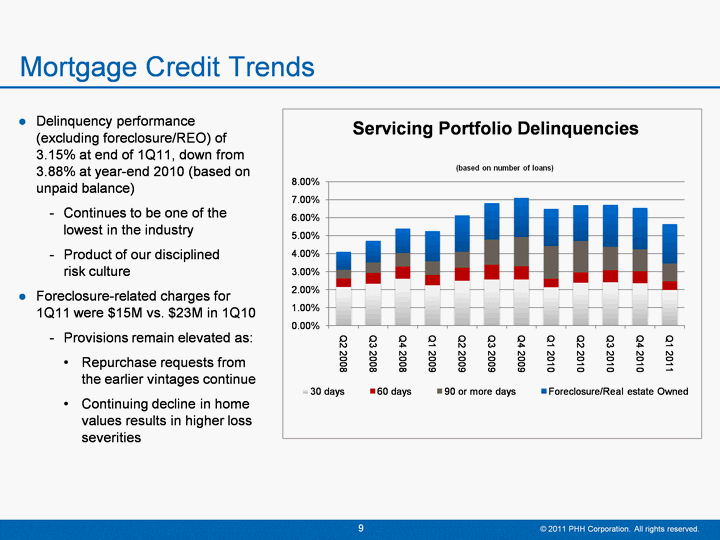
| Delinquency performance (excluding foreclosure/REO) of 3.15% at end of 1Q11, down from 3.88% at year-end 2010 (based on unpaid balance) Continues to be one of the lowest in the industry Product of our disciplined risk culture Foreclosure-related charges for 1Q11 were $15M vs. $23M in 1Q10 Provisions remain elevated as: Repurchase requests from the earlier vintages continue Continuing decline in home values results in higher loss severities Mortgage Credit Trends Servicing Portfolio Delinquencies (CHART) |
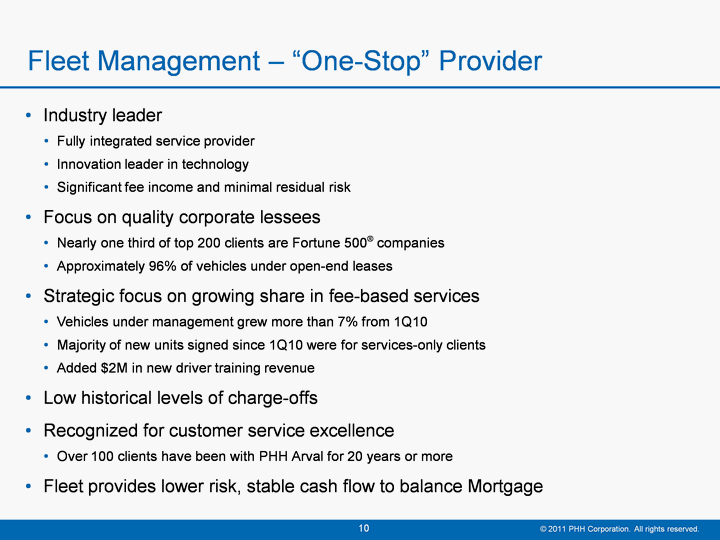
| Fleet Management - "One-Stop" Provider Industry leader Fully integrated service provider Innovation leader in technology Significant fee income and minimal residual risk Focus on quality corporate lessees Nearly one third of top 200 clients are Fortune 500(r) companies Approximately 96% of vehicles under open-end leases Strategic focus on growing share in fee-based services Vehicles under management grew more than 7% from 1Q10 Majority of new units signed since 1Q10 were for services-only clients Added $2M in new driver training revenue Low historical levels of charge-offs Recognized for customer service excellence Over 100 clients have been with PHH Arval for 20 years or more Fleet provides lower risk, stable cash flow to balance Mortgage |
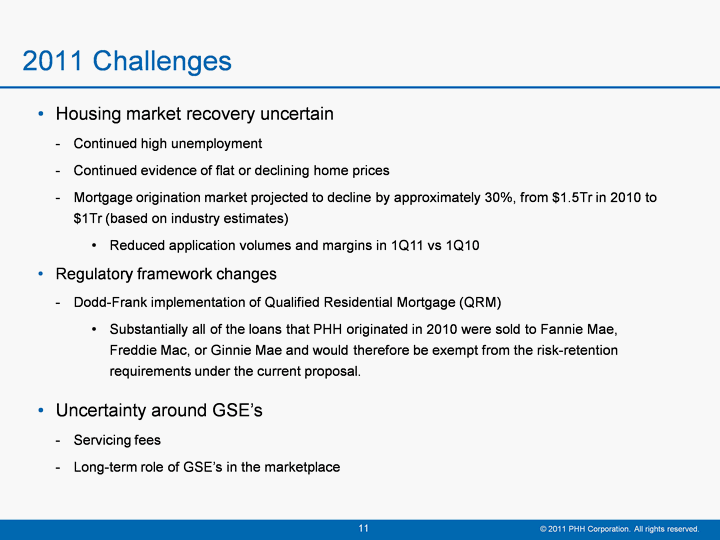
| 2011 Challenges Housing market recovery uncertain Continued high unemployment Continued evidence of flat or declining home prices Mortgage origination market projected to decline by approximately 30%, from $1.5Tr in 2010 to $1Tr (based on industry estimates) Reduced application volumes and margins in 1Q11 vs 1Q10 Regulatory framework changes Dodd-Frank implementation of Qualified Residential Mortgage (QRM) Substantially all of the loans that PHH originated in 2010 were sold to Fannie Mae, Freddie Mac, or Ginnie Mae and would therefore be exempt from the risk-retention requirements under the current proposal. Uncertainty around GSE's Servicing fees Long-term role of GSE's in the marketplace |

| Why Invest in PHH - Well-Positioned to Succeed Excellent opportunities to build profitable mortgage market share Regulatory and capital pressures drive strong interest from Private Label prospects Significant space for additional penetration of existing Private Label and Real Estate relationships Fleet focus on higher ROE business Increasing fee-based services to existing customers Shift in vehicle mix Eventual increase in interest rates should strengthen servicing earnings Increase in value of mortgage servicing portfolio with weighted average coupon < 5% Negative drag on escrow balance will decrease or reverse Mortgage delinquencies appear headed toward normalized levels Despite overhang of foreclosures, 30/60/90 delinquencies at lowest levels since 2008 Investing transformation savings in technology and capabilities to drive scalability and operating flexibility in both Fleet and Mortgage Driving to be most efficient provider of Mortgage and Fleet services, delivering high levels of service to customers, and sustainable, attractive returns to shareholders |

| (CHART) Why Invest in PHH - Potential for Sustainable ROE Growth |

| Note Regarding Non-GAAP Financial Measures Core earnings (loss) (pre-tax and after-tax) and core earnings (loss) per share are financial measures that are not in accordance with GAAP. See Non-GAAP Reconciliations at the back of this release for a reconciliation of these measures to the most directly comparable GAAP financial measures. Core earnings (loss) (pre-tax and after-tax) and core earnings (loss) per share measure the Company's financial performance excluding certain unrealized changes in value of mortgage servicing rights that are based upon projections of future voluntary and involuntary prepayments. The unrealized changes in value of our mortgage servicing rights for voluntary and involuntary prepayments are reflected as market-related and credit related fair value adjustments, respectively. Core earnings (loss) (pre-tax and after-tax) and core earnings (loss) per share may also include other adjustments, as applicable based upon facts and circumstances, consistent with the intent of providing investors a means of evaluating our core operating performance. The Company believes that these Non-GAAP Financial Measures can be useful to investors because they provide a means by which investors can evaluate the Company's underlying key drivers and operating performance of the business, exclusive of certain adjustments and activities that investors may consider to be unrelated to the underlying economic performance of the business for a given period. The Company also believes that any meaningful analysis of the Company's financial performance by investors requires an understanding of the factors that drive the underlying operating performance which can be obscured by significant unrealized changes in value of our mortgage servicing rights in a given period that is included in Segment profit (loss), Income (loss) before income taxes, Net income (loss) attributable to PHH Corporation and Basic earnings (loss) per share attributable to PHH Corporation in accordance with GAAP. Use of Core Earnings by Management The unrealized changes in the value of mortgage servicing rights are based upon numerous assumptions, which include estimated changes in future prepayments that may or may not be actually realized in the future. The market-related fair value adjustments are based upon assumptions of future interest rates, the shape of the yield curve, volatility and other factors. The credit-related fair value adjustments are based upon projected levels of delinquencies and foreclosures that are assumed to remain at current period-end levels throughout the life of the asset for purposes of modeling the expected future cash flows of the mortgage servicing rights. Value lost from actual voluntary and involuntary prepayments are recorded when the underlying loans actually prepay or when foreclosure proceedings are complete, and are included in core earnings based on the current value of the mortgage servicing rights. The Company manages the business and has designed certain management incentives based upon the achievement of core earnings targets. In addition, the Company believes that it will likely replenish most, if not all, realized value lost from changes in value from actual prepayments through new loan originations and actively manages and monitors economic replenishment rates to measure our ability to continue to do so. Therefore, management does not believe the unrealized change in value of the mortgage servicing rights is representative of the economic change in value of the business as a whole. The presentation of core earnings is designed to more closely align the timing of recognizing the actual value lost from prepayments in the mortgage servicing segment with the associated value created through new originations in the mortgage production segment. Limitations on the Use of Core Earnings Since core earnings (loss) (pre-tax and after-tax) and core earnings (loss) per share measure the Company's financial performance excluding certain unrealized changes in value of mortgage servicing rights, they may not reflect the rate of value lost on subsequent actual payments or prepayments over time. As such, core earnings (loss) (pre-tax and after-tax) and core earnings (loss) per share may tend to overstate operating results in a declining interest rate environment and understate operating results in a rising interest rate environment. Core earnings (loss) (pre-tax and after-tax) and core earnings (loss) per share involves differences from Segment profit (loss), Income (loss) before income taxes, Net income (loss) attributable to PHH Corporation and Basic earnings (loss) per share attributable to PHH Corporation computed in accordance with GAAP. Core earnings (loss) (pre-tax and after-tax) and core earnings (loss) per share should be considered as supplementary to, and not as a substitute for, Segment profit (loss), Income (loss) before income taxes, Net income (loss) attributable to PHH Corporation or Basic earnings (loss) per share attributable to PHH Corporation computed in accordance with GAAP as a measure of the Company's financial performance. Non-GAAP Financial Measures |
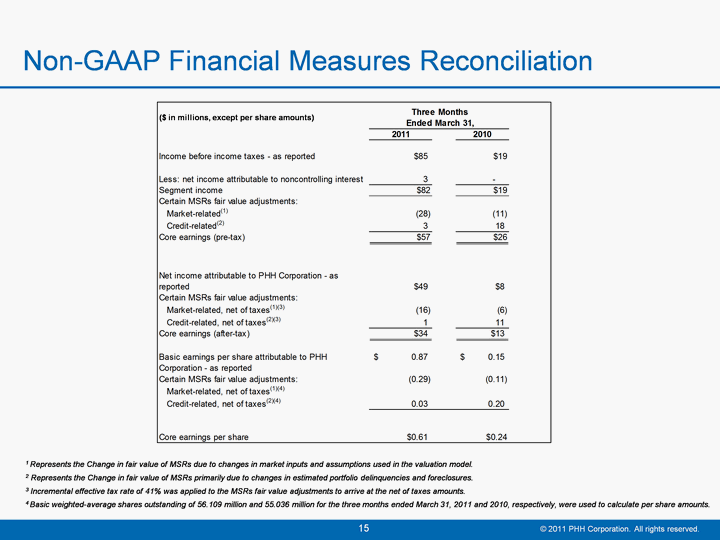
| Non-GAAP Financial Measures Reconciliation 1 Represents the Change in fair value of MSRs due to changes in market inputs and assumptions used in the valuation model. 2 Represents the Change in fair value of MSRs primarily due to changes in estimated portfolio delinquencies and foreclosures. 3 Incremental effective tax rate of 41% was applied to the MSRs fair value adjustments to arrive at the net of taxes amounts. 4 Basic weighted-average shares outstanding of 56.109 million and 55.036 million for the three months ended March 31, 2011 and 2010, respectively, were used to calculate per share amounts. ($ in millions, except per share amounts) |

| Non-GAAP Financial Measures Reconciliation by Segment - 1Q11 vs. 1Q10 1 Represents the Change in fair value of MSRs due to changes in market inputs and assumptions used in the valuation model. 2 Represents the Change in fair value of MSRs primarily due to the impact of changes in estimated portfolio delinquencies and foreclosures. ($ millions) |
